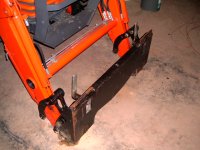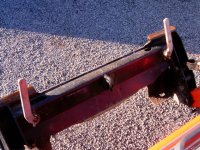plowhog, It is easy to see that your cross tube is twisted:
View attachment 731625
Quite true. Whether we can see his torque tube or not,
whatever is between the two shoes has to be, and is, twisted. Here is a picture below of my torque tube that goes on an SSQA for a Massey DL250 loader. [Black, with white shipping labels.] Since you cannot see the shoes mating with the attachments from the driver's seat I once caught the left side shoe under the lip of a 1000lb bucket and lifted it with the right one unknowingly not engaged. It bent this square torque tubing so badly I just replaced it since I lack a welder and fabrication tools.
So what the OP needs to do is to get the torque tube straightened (whether cut and rewelded or whatever. If I were you, I would reinforce the tube or replace it with one twice the diameter/thickness.) Once the tube is straight and the two shoes line up at the same vertical angle, his hyd cylinder will have the same "amount of shiny cylinder shaft exposed."
The cylinders share equal hyd pressure via a common fitting and are NOT part of the problem. The cylinders are just along for the ride.
A big waste of time to worry over or investigate the cylinders.
BUT the plot can thicken (and maybe has in the OP case...??) Besides the obvious torque tube twist, you
MAY have a a slightly sprung loader frame. They are very hard to diagnose. Best I can suggest is find a perfectly flat concrete pad, make sure tire pressures are not radically different side to side, and then measure the vertical distance from the concrete to the bottom edge of steel where that 2.5 or 3" cross tube is in your loader frame -- whatever reference point is identical on both sides of the frame. One of those bolt heads? Whatever. If there is more than a half inch or so difference side to side you have a sprung loader frame. [I forgot if you measured this and told us before??] One visual (after fixing the torque tube) is to put a wide attachment with a flat top like a bucket on the loader frame and raise it to where you can barely see the top of the bucket on the far left or right from the drivers seat. At that point you should be able to see any significant twist in the loader frame. If you can't, it isn't worth worrying about.
Yes, I have unfortunate experience there. Involves an old locust tree stump. Suffice it to say the corner of a wide bucket is not the best thing to put huge lifting forces on, full power, 4WD, low gear, etc. You can bend a loader frame... and none of the loader manufacturers specify ANYTHING about torque on their products. Neither does the national tractor testing lab in Nebraska test for any such unlisted specs. If you can't/don't want to live with a sprung loader frame, you have a couple of options which I have described in a post here several years back. 1) You can spend upwards of $500 in a frame straightening rig at a big well equipped auto body shop (plus getting the thing off and back on...) or 2) You can go reverse spring it yourself until it is level. I did number 2 and it works as long as you agree with yourself to take the risk.
These loader frames combined with how they are mounted to the tractors make for a much more complex structure than the average owner might imagine. The quick detach loader mounts have tolerances and slop in them. You probably cannot see nor measure slight differences side to side. Even when very careful inspection shows NO welds broken and no bowing or bulging, etc. these issues are very had to find or see. Bolts may have given way slightly on one side or the other, etc. There are a good 4 or 5 places at least where mounting dimensions can be off in one direction due to loader frame torque. All 4 or 5 may look OK and not appear to be out of whack from one side to the other, yet they all add up sequentially in one direction in a sprung loader frame.
Hopefully the OP will find his loader frame acceptably level/equal left and right and all he has to do is fix or replace the SSQA torque tube.
Good luck. Let us know the outcome.


